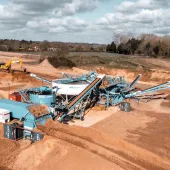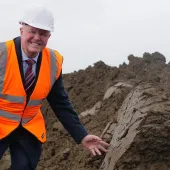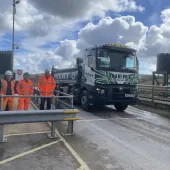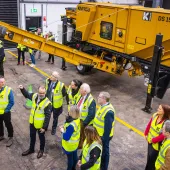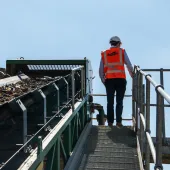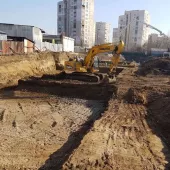Are Current C&D Waste-recycling Targets an Obstacle to Growth?

First published in the October 2015 issue of Quarry Management as A Meaningless Target?
In this opinion piece, Peter Craven, head of marketing at CDE Global, argues that rather than demonstrating success, such targets are masking wider problems in the C&D waste-recycling sector across Europe.
The Waste Framework Directive (WFD) sets a target for 70% recycling of construction, demolition and excavation (C,D&E) waste across Europe by 2020. According to a recent report by Frost & Sullivan, in 2012 the amount of this waste material that was recycled was 61.8%. The straight presentation of this figure alone would indicate that progress is being made and the EU target is achievable.
Closer examination of the figures, however, reveals that there is a huge difference between the top performers and those who, as yet, have not grasped the opportunity presented by construction and demolition waste recycling.
Those member states that are on target have either hit the target already or will do so without much more effort. On the flip side, those member states that will miss the target are so far behind schedule that it is not achievable anyway.
What is the purpose of any target? Surely it is to drive improvements, increase efficiency, and encourage innovation? The 70% recycling target from the WFD does none of these things in its current form. By not addressing this issue now we will waste the next six years waiting to report on a target – when we already know the answer.
The UK, Germany, France, Benelux and the Alpine states will all hit the 70% target – some have reached it already – without having to change anything about how they approach the recycling of construction, demolition and excavation waste for the next six years.
The Nordics, Iberia, Italy and the countries in Central and Eastern Europe will all miss the target – but will have made some investment in basic processing technologies for this material to demonstrate some degree of effort to reach the target.
While the industry focuses its efforts on a meaningless 70% recycling target, the volume of CD&E waste produced across Europe will rise to more than 1.1 billion tonnes a year by 2020 – a 26% increase on the current level.
A recent report from Frost & Sullivan reported that ‘While 95% of this (C&D) waste is reusable, recycling is not being managed properly’.
An EU report from June 2013 entitled ‘Ambitious waste targets and local and regional waste management’ includes the following commentary: ‘…best practices in Europe show that recycling rates over 80% and 90% are feasible. For those countries who are already achieving higher re-use, recycling and recovery rates, the WFD does not provide an incentive to achieve higher targets. In principle, differentiated targets for these member states could be set in the WFD or, alternatively, in their national legislation’.
It is clear that there is recognition from industry commentators and at EU level that the 70% target from the WFD is no longer fit for purpose. However, any search for an alternative seems to have a very blinkered view and fails to ask two very important questions:
- Does a ‘one size fits all’ approach work?
- Are the targets focused in the right way – will they drive efficiency, protect the environment, encourage innovation?
So, does a ‘one size fits all’ approach work? It is obvious from the latest figures available that the targets have created a very clear split between those member states that will achieve the target and those who will not. To be able to accurately predict this six years in advance of the deadline is all the evidence that is required that the current targets need to be looked at again.
If these targets are to be looked at again, it is very clear that they need to be constructed with some allowances made for the individual market conditions within each member state.
Member states where there are limited volumes of virgin materials are obviously going to perform better than states where virgin materials are in abundance. Member states with high landfill taxes are obviously incentivizing the recycling of C&D waste material. There are some member states with relatively very low landfill costs, so the disposal of C&D waste is still the most economically viable option. While this is not sustainable in the long term, landfill taxes would need to rise by a huge multiple to bring these member states into line with others where high landfill charges already exist. This is simply not achievable by the 2020 deadline as no sitting government is going to preside over an increase as dramatic as this.
All of this assumes that simply measuring the volume of C&D waste that is recycled is the best way to drive improvements and innovation in the sector. This leads on to the second question: Are the targets focused in the right way – will they drive efficiency, protect the environment, encourage innovation?
The vast majority of CD&E waste in Europe is processed using basic processing technologies – basic size reduction (crushing) and classification (screening) technology is employed. The end result is recycled products that are only suitable for very low value construction applications (roadbase, general fill etc). It is also clear that backfilling is still the dominant application for most of the recycled construction, demolition and excavation waste in Europe.
Within the WFD targets to be achieved by 2020 are ‘Preparation for re-use, recycling and backfilling of 70% construction and demolition waste’. This seems to suggest that there is recognition that backfilling does not constitute recycling – yet when material is used for backfilling it is currently included within the recycling rates reported by the member states.
The reason for including backfilling within the reported numbers is easy to understand – it makes it very easy to hit the 70% target by simply introducing the most basic processing technologies and producing material with little or no commercial value. This is a fundamental flaw in the current approach to CD&E waste recycling in Europe.
The targets, as they currently exist, are simply aimed at reducing the volume of CD&E waste that is sent to landfill. This fails to recognize the valuable resource that CD&E waste is and the potential that exists for the production of higher-value materials from this waste stream.
While there is no doubt that there is a requirement for materials to be used in low-value construction applications, this is not doing anything for the perception of recycled aggregates when this is seen by many as the only potential use for this material. By introducing the advanced processing systems available for the processing of CD&E waste, it is possible to expand the range of applications for this material and change the perception of recycled sand and aggregates. It is only by doing this that it will be possible to achieve the aim of maximizing the potential that exists from the efficient recycling of C,D&E waste.
For example, the evidence exists that recycled aggregates are a viable alternative to virgin aggregates in concrete – yet only a tiny proportion of recycled material across Europe is currently used in concrete manufacturing. Australian government guidelines state that up to 30% of recycled aggregate can be used for structural concrete without any noticeable difference in workability and strength when compared with virgin aggregates.
Many in the virgin aggregates business see recycled material as a threat when, in fact, it is exactly the opposite. The exploitation of recycled aggregates to their full potential ensures we protect aggregate supply from a sustainable source. It prolongs the life of the finite resources over which we are merely the guardians.
So, to answer the question – do the current C&D waste recycling targets drive efficiency, protect the environment and encourage innovation? – the answer is a resounding ‘no’.
If, instead, we target the increased use of recycled C&D waste into higher-value construction applications, such as concrete, we can turn this around. This would encourage the use of the advanced processing technologies that exist for this material and which are capable of producing recycled sand and aggregates with a much broader scope of application.
Increased specification of these higher-value materials builds trust in the material and improves the perception of recycled material, leading to increased demand. This, in turn, creates demand for these advanced processing systems from material producers who need to invest in this technology to stay competitive and meet the new demands of their customers.
Likewise, this, in turn, forces equipment manufacturers to continue to develop new ways of processing this material – to drive innovation in the processing technologies available in order to maintain their own competitive advantage.
All of these factors combine to change the perception of recycled material and ensure we are in a position to efficiently deal with the 1.1 billion tonnes of waste material that will be generated across Europe by 2020.
Another indirect benefit of being proactive in this is that it helps address the difficulties in recruiting people to the construction materials and recycling sectors. By playing a part in demonstrating that we are operating in a 21st century industry that is prepared to go over and above basic adherence to legislation; and by demonstrating our commitment to sustainability and maximizing value from recycled materials, we make our industry a much more attractive proposition as an innovative sector with a bright future.
This is essential if we are to remain relevant, stay viable and secure the future innovation that will keep our sector thriving and strong.
- Subscribe to Quarry Management, the monthly journal for the mineral products industry, to read articles before they appear on Agg-Net.com

